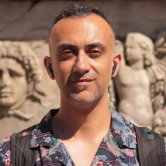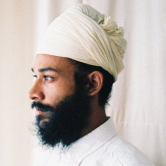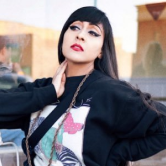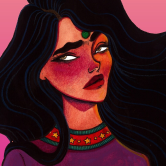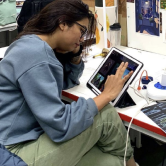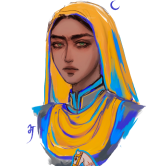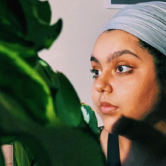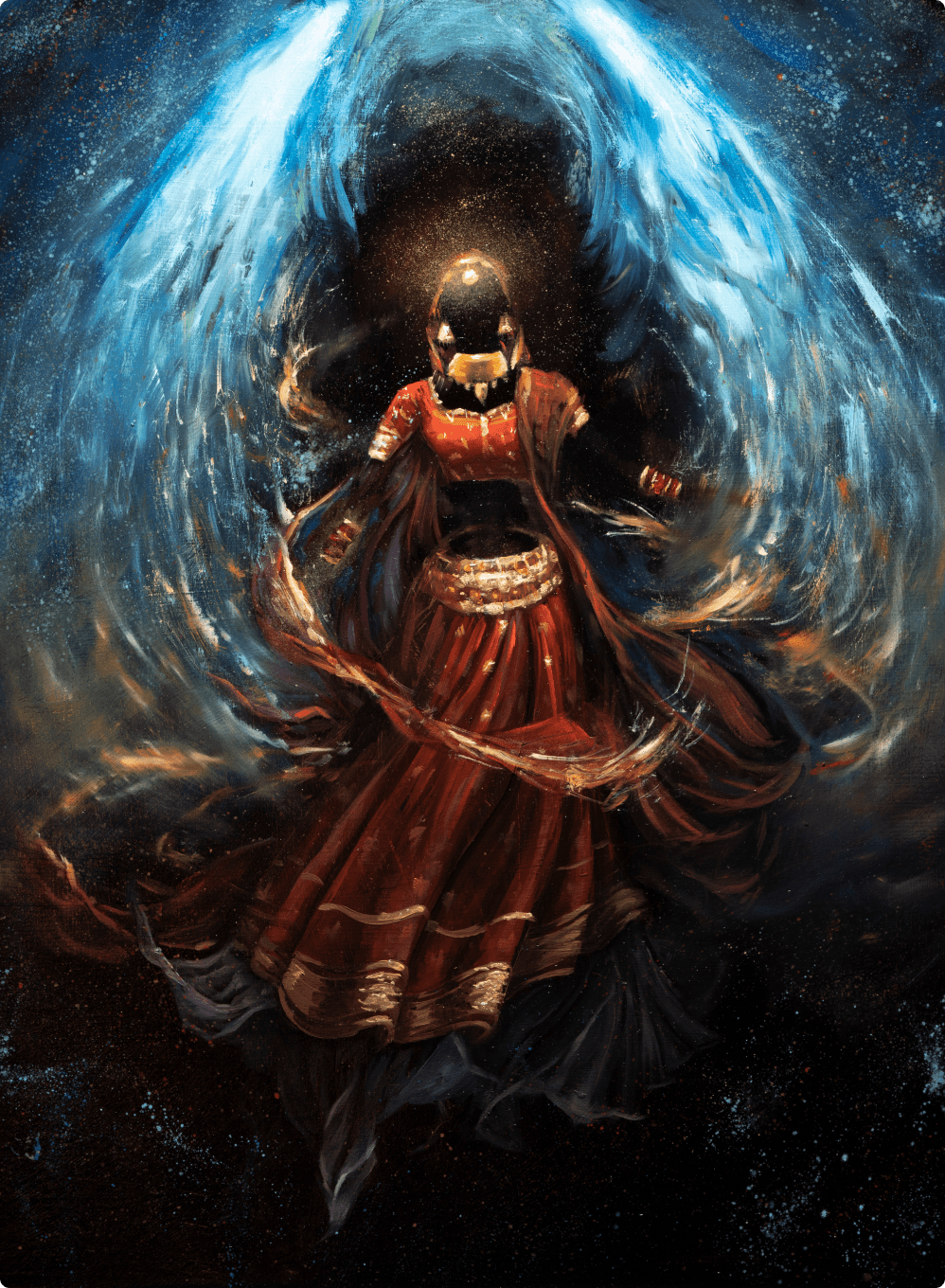
COVER
Artist: Mani Dhaliwal
Title: Soul Bride
Medium: Oil Painting
Commissioner: Manjinder Tiwana
Title: Soul Bride
Medium: Oil Painting
Commissioner: Manjinder Tiwana
Sikhi, the path of the Guru, describes enlightenment as the game of uniting with the Divine. In
explaining this process, the Gurus frequently use the metaphor of a young bride-to-be marrying her
husband.
In this metaphor, everyone, regardless of gender, is considered as the bride, hoping to achieve union with her husband, and with that union to experience the bliss of unity. In these writings, the Guru takes on the voice of a woman in their poetry, describing how the fortunate bride attracts the Divine, in the form of the husband.
“The fortunate bride decorates herself, placing a garland of good virtues around her neck.” — Ang 426, Raag Aasaa, written by Guru Amar Das Ji
The jewellery of good qualities, humility, sweet speech, truthfulness, compassion, friendliness, admiration, and loving devotion attracts and binds the husband to the bride.
With these qualities a union is created, and the bliss of that unity is analogous to enlightenment, a letting go of one’s past identity and merging into one’s Beloved. The history of Sikh women is filled with stories of how these qualities were practised by foundational visionaries, women who were involved in fashioning the institutions of the community from the very beginning.
The calendar attempts to visually convey these stories which have long been ignored.
In this metaphor, everyone, regardless of gender, is considered as the bride, hoping to achieve union with her husband, and with that union to experience the bliss of unity. In these writings, the Guru takes on the voice of a woman in their poetry, describing how the fortunate bride attracts the Divine, in the form of the husband.
“The fortunate bride decorates herself, placing a garland of good virtues around her neck.” — Ang 426, Raag Aasaa, written by Guru Amar Das Ji
The jewellery of good qualities, humility, sweet speech, truthfulness, compassion, friendliness, admiration, and loving devotion attracts and binds the husband to the bride.
With these qualities a union is created, and the bliss of that unity is analogous to enlightenment, a letting go of one’s past identity and merging into one’s Beloved. The history of Sikh women is filled with stories of how these qualities were practised by foundational visionaries, women who were involved in fashioning the institutions of the community from the very beginning.
The calendar attempts to visually convey these stories which have long been ignored.
Artist
Mani Dhaliwal
Manmeet Dhaliwal (Mani D) is a student of art. When not at his day job as an Engineer, he is learning and practicing the skills of drawing and painting, and has been doing so for 5 years. He studies mostly online, but also through various in-person classes. His inspirations include Jeffrey Watts, Jeremy Lipking, Anders Zorn, and many others. He prefers painting in oil, and drawing with charcoal. Currently he is focused on portraiture and landscapes, but is always experimenting with various mediums, techniqures, and subject matters, to find his ultimate style. He prefers to focus on the technical side of art, and let the audience determine the message of the works themselves.
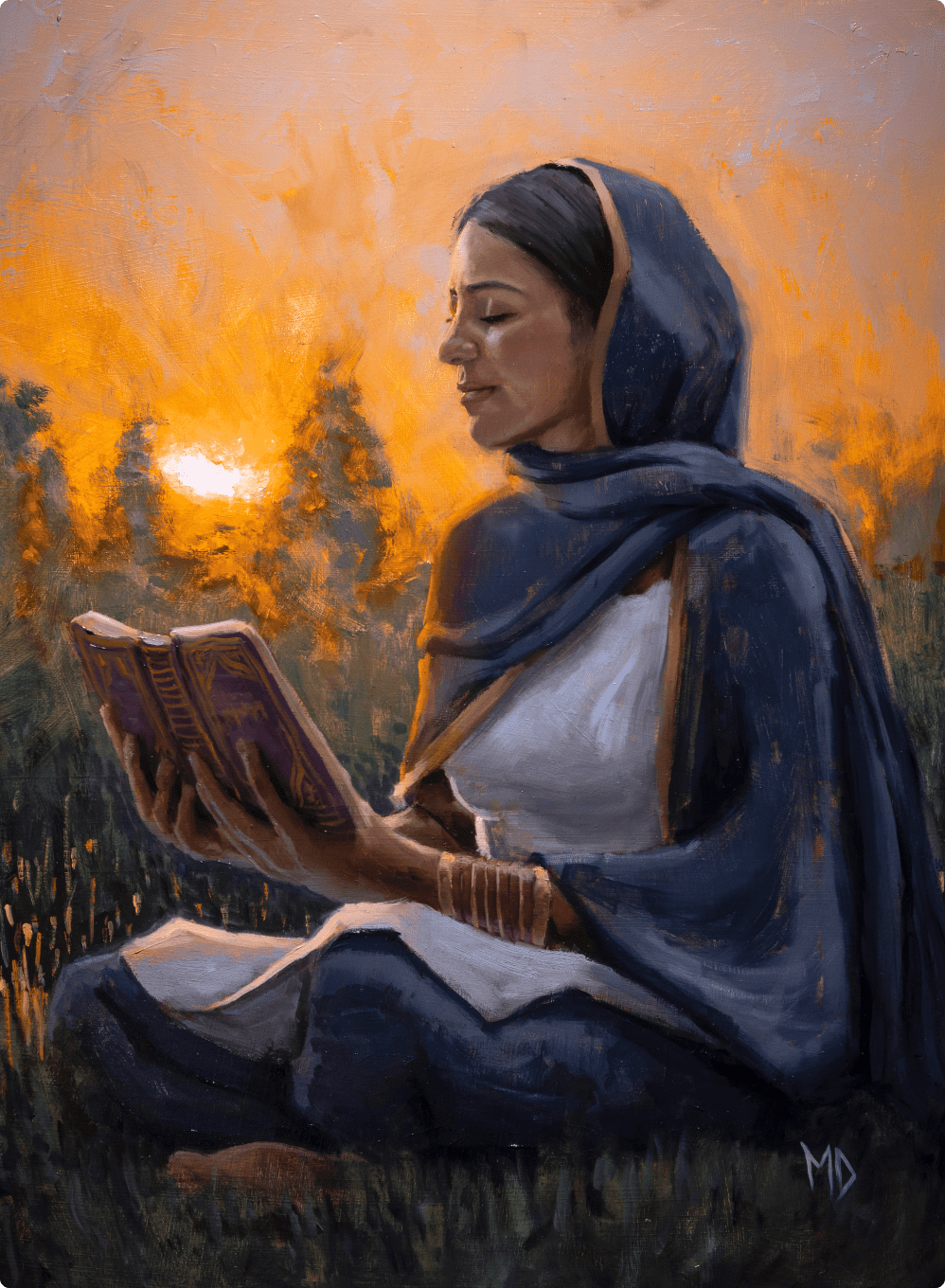
JANUARY
Artist: Mani Dhaliwal, CA
Title: Bibi Amro
Medium: Oil Painting
Commissioner: Sarbjit Singh
Title: Bibi Amro
Medium: Oil Painting
Commissioner: Sarbjit Singh
Bibi Amro was the daughter of Guru Angad Dev Ji and Mata Khivi, and the wife of Bhai Jasoo. She was
taught to read and write in Gurmukhi by her father; and her talent was such that she committed vast
amounts of Sikh scripture to memory.
Her husband’s uncle, Amar Das, would occasionally visit his brother, and it was on one such visit that Amar Das heard the sweet voice of Bibi Amro singing Gurbani.
From this transformative meeting, the elderly Amar Das, moved by the melodic sweetness of Gurbani, would go on to spend years in the service of Guru Angad Dev Ji. Amar Das would ultimately go on to succeed Guru Arjan Dev Ji as the third Guru, known henceforth as Guru Amar Das Ji.
Guru Amar Das Ji propagated a structure to the Sikh community and appointed Bibi Amro as the head of one of the 22 districts that were formed. Bibi Amro was responsible for all aspects of administration and was influential in the choice of Amritsar as the spiritual home for Sikhs.
Her husband’s uncle, Amar Das, would occasionally visit his brother, and it was on one such visit that Amar Das heard the sweet voice of Bibi Amro singing Gurbani.
From this transformative meeting, the elderly Amar Das, moved by the melodic sweetness of Gurbani, would go on to spend years in the service of Guru Angad Dev Ji. Amar Das would ultimately go on to succeed Guru Arjan Dev Ji as the third Guru, known henceforth as Guru Amar Das Ji.
Guru Amar Das Ji propagated a structure to the Sikh community and appointed Bibi Amro as the head of one of the 22 districts that were formed. Bibi Amro was responsible for all aspects of administration and was influential in the choice of Amritsar as the spiritual home for Sikhs.
Artist
Mani Dhaliwal
Manmeet Dhaliwal (Mani D) is a student of art. When not at his day job as an
Engineer, he is learning and practicing the skills of drawing and painting, and has
been doing so for 5 years. He studies mostly online, but also through various
in-person classes. His inspirations include Jeffrey Watts, Jeremy Lipking, Anders
Zorn, and many others. He prefers painting in oil, and drawing with charcoal.
Currently he is focused on portraiture and landscapes, but is always experimenting
with various mediums, techniqures, and subject matters, to find his ultimate style.
He prefers to focus on the technical side of art, and let the audience determine the
message of the works themselves.
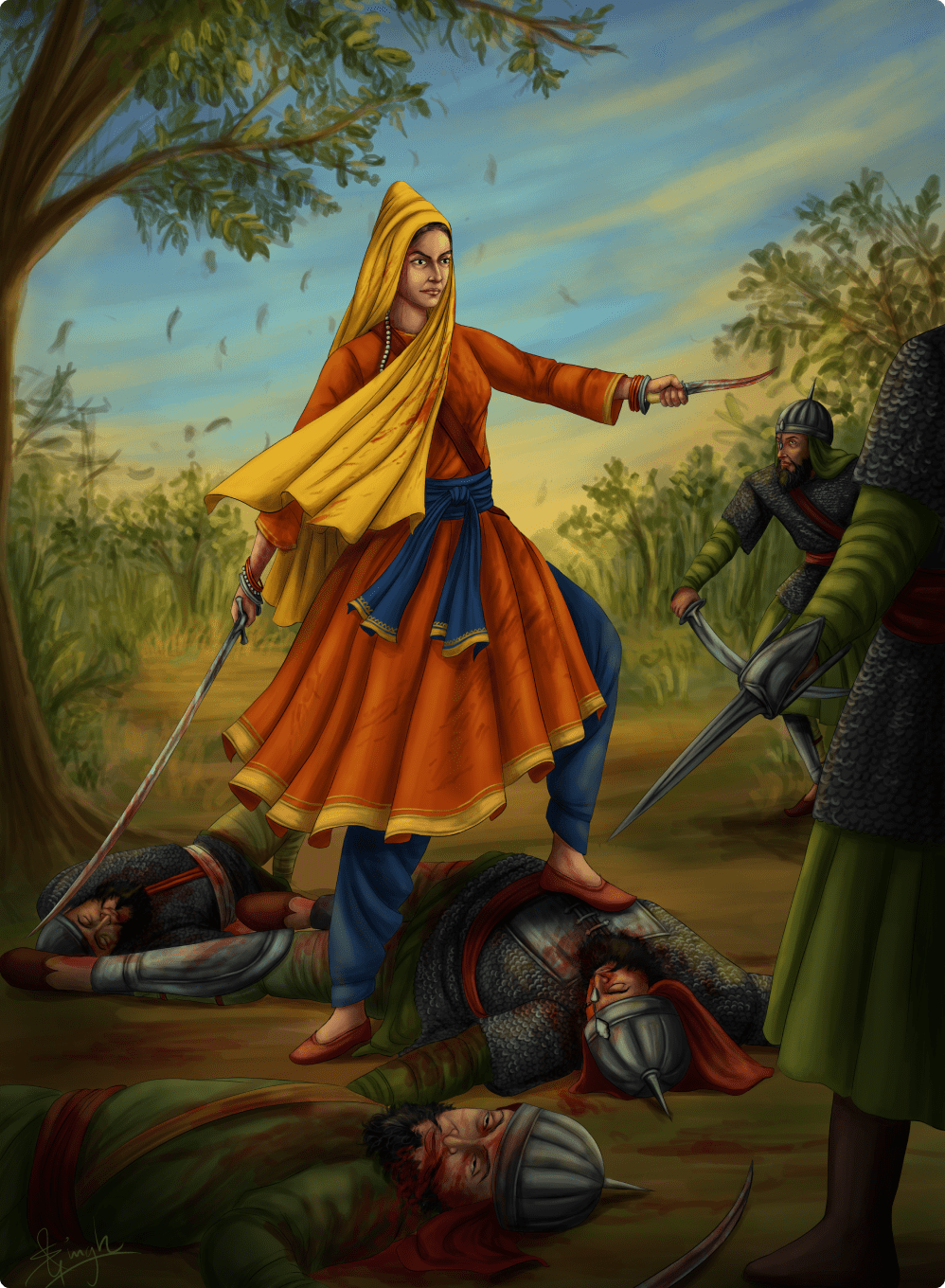
FEBRUARY
Artist: Sharandeep Singh, IND
Title: Deep Kaur
Medium: Digital Art
Commissioner: Inder Bassi
Title: Deep Kaur
Medium: Digital Art
Commissioner: Inder Bassi
The brave Deep Kaur earned great fame on a trip from her local village to see Guru Gobind Singh Ji
at Anandpur Sahib.
The group she was travelling with had split into two separate parties, and it was whilst Deep Kaur travelled alone to catch up with the other group that she was encircled and harassed by four local thugs; throwing her to the ground in order to rob her.
When one thug bent over the prone Deep Kaur, she grabbed his sword and quickly chopped him down, before striking down the other three. When the other group of Sikhs approached, they saw Deep Kaur sitting on top of one of the corpses, with the other three around her.
When they reached Anandpur Sahib she received great praise from Guru Gobind Singh Ji, who instructed other women in the congregation to also adorn such a brave Goddess spirit.
The group she was travelling with had split into two separate parties, and it was whilst Deep Kaur travelled alone to catch up with the other group that she was encircled and harassed by four local thugs; throwing her to the ground in order to rob her.
When one thug bent over the prone Deep Kaur, she grabbed his sword and quickly chopped him down, before striking down the other three. When the other group of Sikhs approached, they saw Deep Kaur sitting on top of one of the corpses, with the other three around her.
When they reached Anandpur Sahib she received great praise from Guru Gobind Singh Ji, who instructed other women in the congregation to also adorn such a brave Goddess spirit.
Artist
Sharandeep Singh, IND
I am Punjab based Digital Artist, known as Sarbloh Arts from my social media pages. I do not have an art degree, I just use it to express my thoughts and imagination. Sikh History is the source of my inspiration and the only mission I have is to illustrate the entire Sikh History timeline in my art style. Sarbloh Arts is the name under which I will fulfill my mission of documenting Sikh history through art.
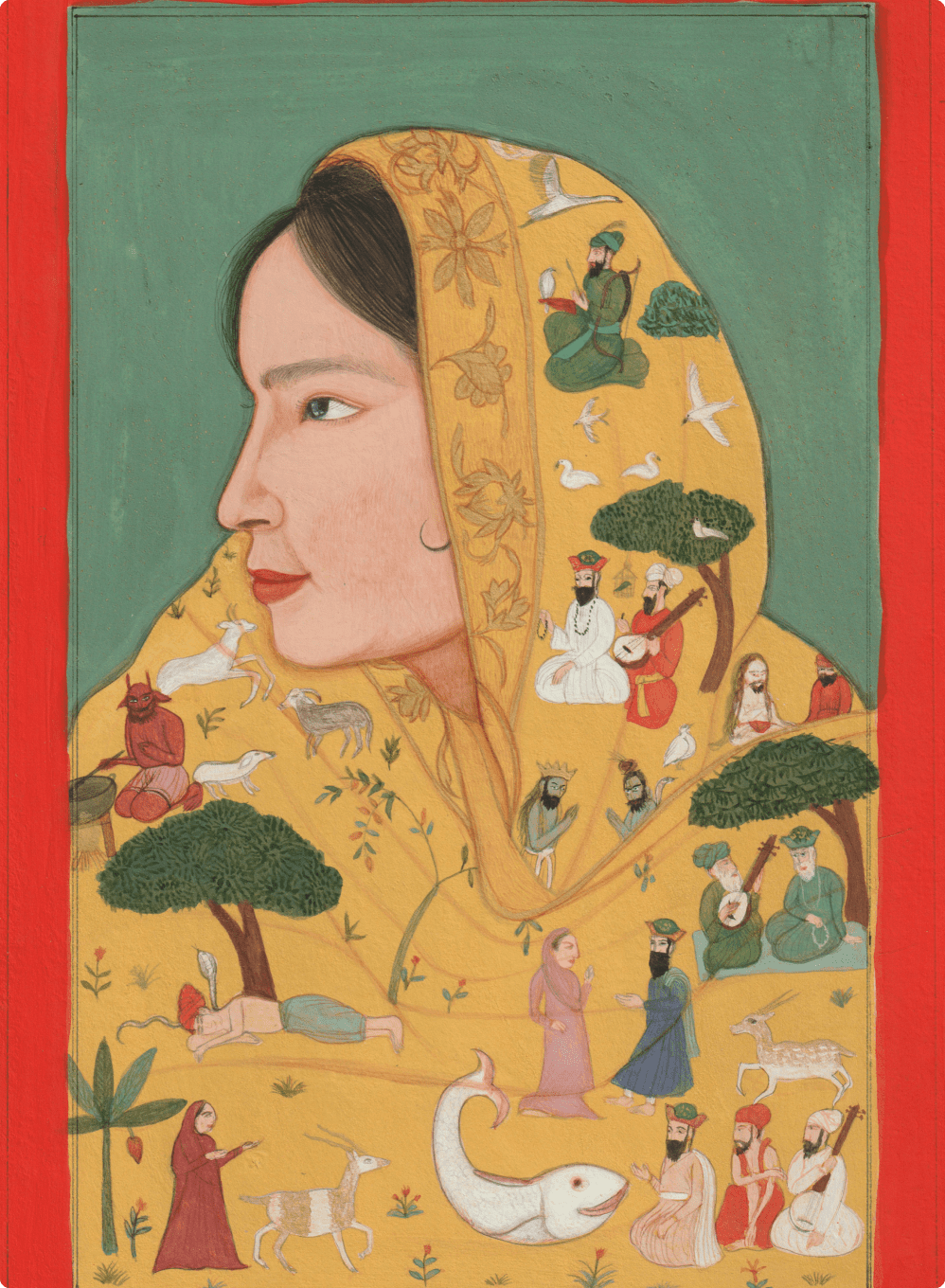
MARCH
Artist: Jatinder Singh Durhailay, UK
Title: Bebe Nanaki
Medium: Miniature Painting
Commissioner: Amardeep Sanghera
Title: Bebe Nanaki
Medium: Miniature Painting
Commissioner: Amardeep Sanghera
Bebe Nanaki, considered to be the first Sikh, was the first to recognise her younger brother, Guru
Nanak Dev Ji’s presence, prowess and profound perspectives. As such, she defended Guru Ji from
negative comments and misconceptions, as she was able to better recognise the true, transcendent
nature of Guru Nanak Dev Ji.
Bebe Nanaki exemplified the essence of Seva. She would offer Guru Nanak Dev Ji a job at her husband’s shop, open up her own home in Sultanpur to Guru Ji and his wife and later, would gift Guru Nanak Dev Ji the Rabab that Bhai Mardana went on to play in accompaniment. She also played a significant role in raising Baba Sri Chand.
Bebe Nanaki took her last breath in the arms of her brother, as Guru Ji recited Japji Sahib.
Bebe Nanaki exemplified the essence of Seva. She would offer Guru Nanak Dev Ji a job at her husband’s shop, open up her own home in Sultanpur to Guru Ji and his wife and later, would gift Guru Nanak Dev Ji the Rabab that Bhai Mardana went on to play in accompaniment. She also played a significant role in raising Baba Sri Chand.
Bebe Nanaki took her last breath in the arms of her brother, as Guru Ji recited Japji Sahib.
Artist
Jatinder Singh Durhailay, UK
Jatinder Singh Durhailay born in 1988 in London, United-Kingdom. He received a
Bachelor of the Arts from University Arts London in 2011 and has been active as a
painter since. In addition to his beautiful paintings depicting Indian Sikh culture,
Durhailay’s colourful drawing and watercolour work have as well drawn a wide fan
base, while his practice has been praised within the art scene.
Jatinder Singh Durhailay’s work has appeared in many exhibitions around the world,
and also sold at Scope Miami Art Basel in 2012. His talent, which can not be simply
confined into Contemporary Indian Art or British Contemporary Painting, has gathered
attention around the world with collectors in Europe, Asia and the USA. Some of the
artist’s latest work appeared in “Empire, Faith and War” (Brunei Gallery, London UK
2014) and “State of Origin” (Unit24 Gallery, London UK 2014).
Durhailay is also trained in Indian Classical Music, performing and practicing
Kirtan as well as playing among others, the rare Instrument that are the Dilruba and
Taus.
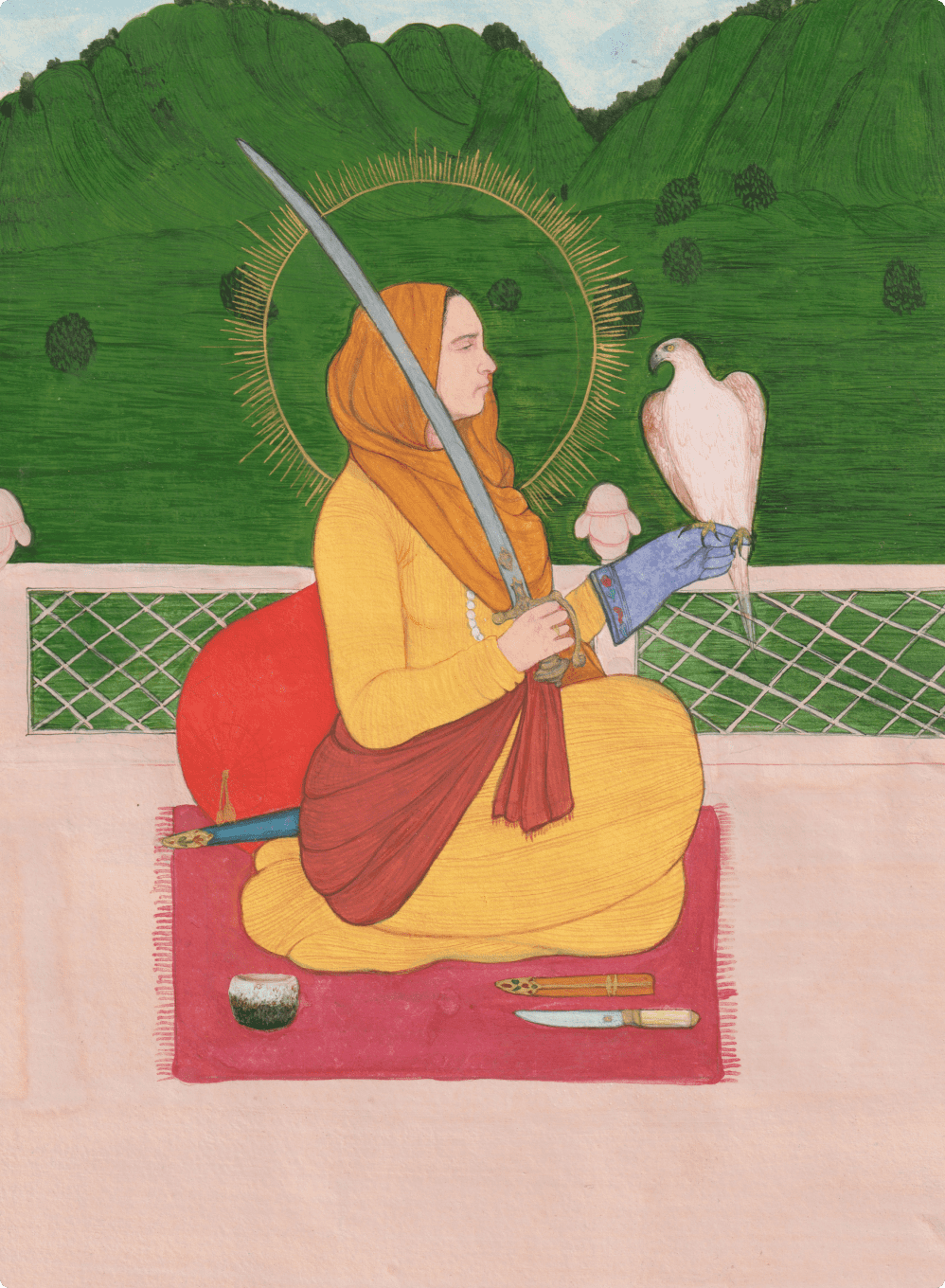
APRIL
Artist: Jatinder Singh Durhailay, UK
Title: Mata Sahib Deva
Medium: Miniature Painting
Commissioner:
Title: Mata Sahib Deva
Medium: Miniature Painting
Commissioner:
Mata Sahib Deva, the empress of the Sikh community and mother to the Khalsa, held court in Delhi
following Guru Gobind Singh Ji’s passing in 1708.
She would direct the Khalsa on socio-political matters whilst also heading humanitarian endeavours like the creation of wells for the congregation. Addressing the community of Khalsa as her children, Mata Ji would perform daily worship to the weapons of Guru Gobind Singh.
A modern take on her name adds the honorific ‘Kaur’, which is understandable since this is the name given to women after they are baptised into the Khalsa panth. However, all of the hukamname (proclamations) that were penned in her own hand after the birth of the Khalsa in 1699 show that she signed her name as Sahib Deva.
She would direct the Khalsa on socio-political matters whilst also heading humanitarian endeavours like the creation of wells for the congregation. Addressing the community of Khalsa as her children, Mata Ji would perform daily worship to the weapons of Guru Gobind Singh.
A modern take on her name adds the honorific ‘Kaur’, which is understandable since this is the name given to women after they are baptised into the Khalsa panth. However, all of the hukamname (proclamations) that were penned in her own hand after the birth of the Khalsa in 1699 show that she signed her name as Sahib Deva.
Artist
Jatinder Singh Durhailay, UK
Jatinder Singh Durhailay born in 1988 in London, United-Kingdom. He received a
Bachelor of the Arts from University Arts London in 2011 and has been active as a
painter since. In addition to his beautiful paintings depicting Indian Sikh culture,
Durhailay’s colourful drawing and watercolour work have as well drawn a wide fan
base, while his practice has been praised within the art scene.
Jatinder Singh Durhailay’s work has appeared in many exhibitions around the world,
and also sold at Scope Miami Art Basel in 2012. His talent, which can not be simply
confined into Contemporary Indian Art or British Contemporary Painting, has gathered
attention around the world with collectors in Europe, Asia and the USA. Some of the
artist’s latest work appeared in “Empire, Faith and War” (Brunei Gallery, London UK
2014) and “State of Origin” (Unit24 Gallery, London UK 2014).
Durhailay is also trained in Indian Classical Music, performing and practicing
Kirtan as well as playing among others, the rare Instrument that are the Dilruba and
Taus.

MAY
Artist: Dilrani Kaur, US
Title: Bibi Mumtaz
Medium: Hand Painting
Commissioner: Gurpal Bhandal
Title: Bibi Mumtaz
Medium: Hand Painting
Commissioner: Gurpal Bhandal
Bibi Mumtaz, the daughter of a Muslim named Nihang Khan, medically served Bhai Bachittar Singh, the
famed horseman, during his last few days after the great Battle of Anandpur Sahib [1704].
Bhai Bachittar Singh was critically wounded during his defence of the rear of Anandpur Sahib, and Nihang Khan, who had a great deal of devotion for Guru Gobind Singh Ji, took in the injured Bhai Bachittar Singh.
Here, Bibi Mumtaz took medical care of Bhai Ji. When enemy soldiers confronted Nihang Khan and accused him of harbouring enemies, Nihang Khan was able to keep Bhai Bachittar Singh, hidden in the darkness of the room, safe under the guise that he was Bibi Mumtaz’s husband. Soon after Bhai Bachittar Singh became Shaheed and Bibi Mumtaz took Nihang Khan’s words as truth – that she was married to Bhai Bachittar Singh. She would spend the rest of her life in meditative reverence of the Guru as Bhai Ji’s widow.
Bhai Bachittar Singh was critically wounded during his defence of the rear of Anandpur Sahib, and Nihang Khan, who had a great deal of devotion for Guru Gobind Singh Ji, took in the injured Bhai Bachittar Singh.
Here, Bibi Mumtaz took medical care of Bhai Ji. When enemy soldiers confronted Nihang Khan and accused him of harbouring enemies, Nihang Khan was able to keep Bhai Bachittar Singh, hidden in the darkness of the room, safe under the guise that he was Bibi Mumtaz’s husband. Soon after Bhai Bachittar Singh became Shaheed and Bibi Mumtaz took Nihang Khan’s words as truth – that she was married to Bhai Bachittar Singh. She would spend the rest of her life in meditative reverence of the Guru as Bhai Ji’s widow.
Artist
Dilrani Kaur, US
Dilrani Kaur is a multi-disciplinary artist born Leeds, in the North of England who recently relocated to Dallas USA. Her work encompasses dance, music and visual art. From a young age, she has been training in Bharatanatyam, Kathak and Santoor and continues to be involved in regular performances, workshops and projects. Dilrani’s art grew from her interest in mehndi and she now creates work on paper, the body and other mediums. Inspired by symmetry, many of her designs include themes of faith, nature and abstract aesthetics.
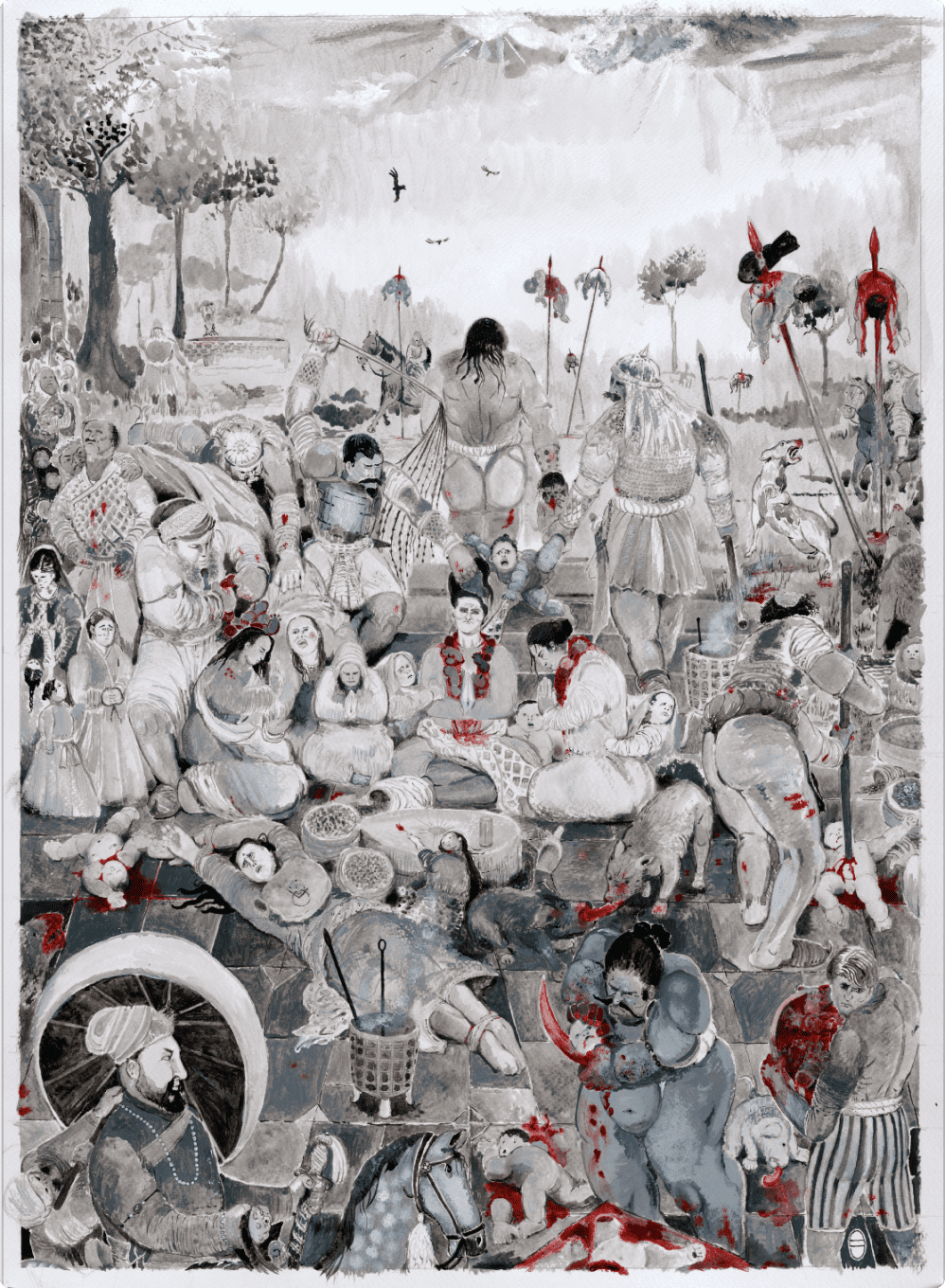
JUNE
Artist: Balkishan Jhumat, UK
Title: Courtyard of Horrors
Medium: Acrylic on Canvas
Commissioner: Gurpreet Sidhu
Title: Courtyard of Horrors
Medium: Acrylic on Canvas
Commissioner: Gurpreet Sidhu
The Governor of Lahore, Mir Mannu, sought to eradicate all Sikhs from his province. Sikh families
were rounded up and sent to Lahore. The men were beheaded, and the remaining family members were
sent to a labour camp, where women were expected to grind over 40 pounds of grain each day.
Freedom was offered to them if they converted to an extremely intolerant version of Islam, but not a single woman abandoned their Guru – they remained unwavering in their Sikh faith, displaying this through their singing of Gurbani.
Mir Mannu escalated his barbarism by ordering children to be slain in front of their mothers. The lifeless bodies of babies, toddlers and children were ripped apart, with the limbs strung into garlands that were placed around the necks of the grieving mothers.
Yet in the face of this, they held steadfast to their identity; remaining defiantly resolute.
Freedom was offered to them if they converted to an extremely intolerant version of Islam, but not a single woman abandoned their Guru – they remained unwavering in their Sikh faith, displaying this through their singing of Gurbani.
Mir Mannu escalated his barbarism by ordering children to be slain in front of their mothers. The lifeless bodies of babies, toddlers and children were ripped apart, with the limbs strung into garlands that were placed around the necks of the grieving mothers.
Yet in the face of this, they held steadfast to their identity; remaining defiantly resolute.
Artist
Balkishan Jhumat, UK
A diligent and disciplined ‘fine artist’ with a creative and unique approach to producing dynamic and original art. Balkishan has literally been passionate about art since primary school. His favourite secondary school subject, not surprisingly, was art! He continued to pursue art and design at college. He chose to study Illustration at university, and in 2001 was awarded a BA (Hons) degree.
He is extremely thankful for being taught by the right kind of tutors throughout his academic history. Tutors who believed in and, nurtured, his abilities. More recently, Balkishan decided to write about his artworks. This culminated in the publication of two books: ‘Beneath the Mirrored Vault, New Perspectives in Sikh Guru Portraiture’. Also, ‘Mythologies, Stories Captured in Graphite’. Both books were published in 2019.
As a professional artist, proficient in virtually any medium in the classical/traditional manner, Balkishan is always keen to reach out to serious patrons and clientele. If you are interested in commissioning art from him please email: info@beyondimage.co.uk
All commissions will be considered.
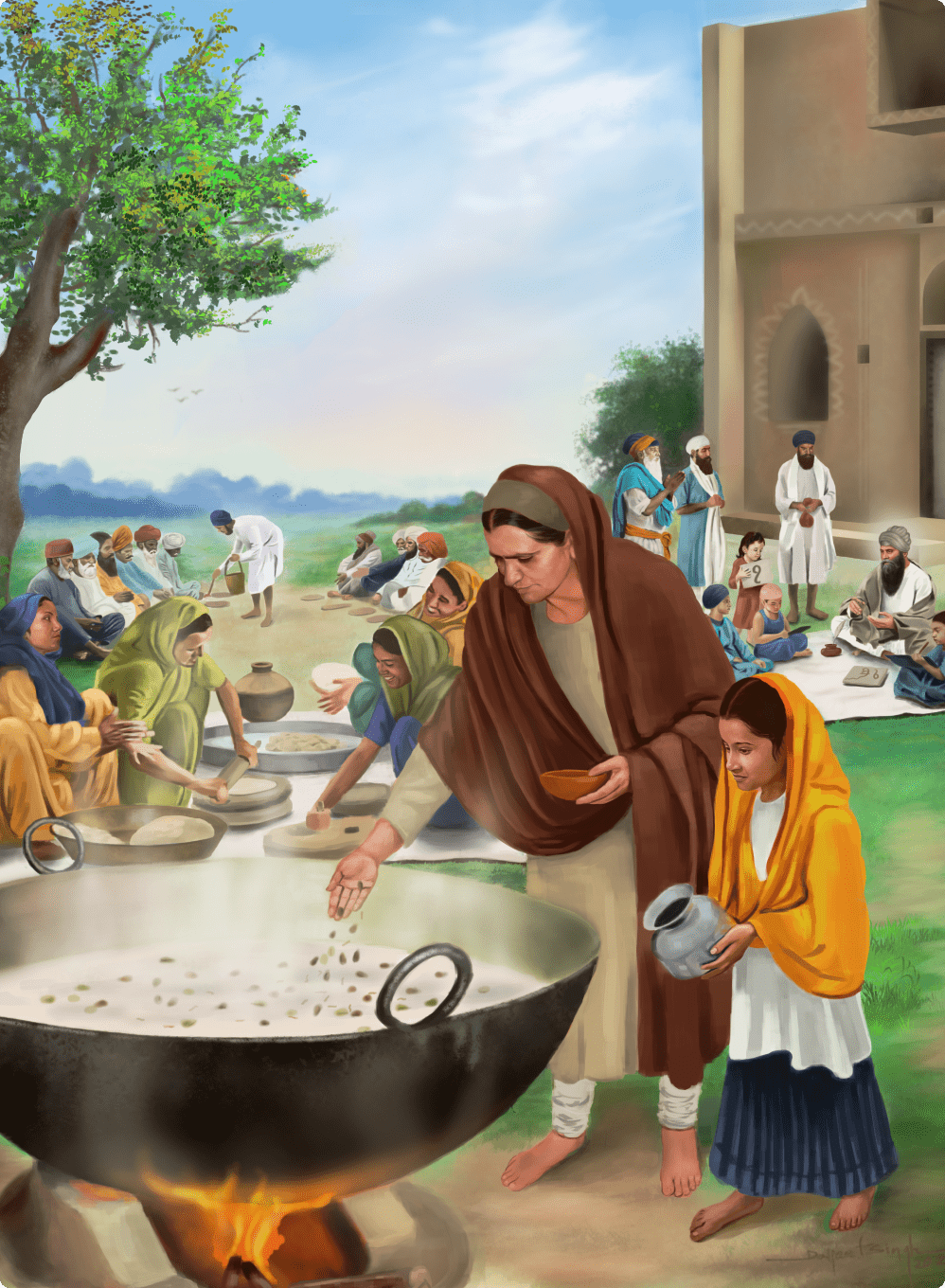
JULY
Artist: Daljeet Singh, IND
Title: Mata Khivi
Medium: Digital Art
Commissioner: Gurjit Bhandal
Title: Mata Khivi
Medium: Digital Art
Commissioner: Gurjit Bhandal
Mata Khivi was the wife of Guru Angad Dev Ji, the second Guru. She was also considered a key
figurehead for the early Sikh community, and has the auspicious honour of being the only Sikh woman
directly mentioned in Guru Granth Sahib Ji:
Balwand says; Khivi, the virtuous wife [of Guru Angad], whose [caring nature] provides such dense shade to all. She serves a great wealth of communal food, delicious like ambrosial nectar, rice pudding with clarified butter. — Ang 967, Raag Ramkali, written by Sata & Balwand
Mata Khivi played an exceptional role in the expansion of langar seva. Living a long life in Khador Sahib, Mata Ji raised four children, the most notable being Bibi Amro, who is also featured in this calendar.
Balwand says; Khivi, the virtuous wife [of Guru Angad], whose [caring nature] provides such dense shade to all. She serves a great wealth of communal food, delicious like ambrosial nectar, rice pudding with clarified butter. — Ang 967, Raag Ramkali, written by Sata & Balwand
Mata Khivi played an exceptional role in the expansion of langar seva. Living a long life in Khador Sahib, Mata Ji raised four children, the most notable being Bibi Amro, who is also featured in this calendar.
Artist
Daljeet Singh, IND
Daljeet Singh is a self-taught fine artist, having a keen interest in different
forms of arts including painting, music and Folk Dance since his childhood. He was
born in 1997, New Delhi, India. He completed his bachelor’s degree in Physics
(Hons.) from SGTB Khalsa College, Delhi University. While pursuing his degree, he
got the opportunity to explore his passion of art and thus joined the fine arts
society of the college. He further designed the covers of the college magazine TEGH
for three consecutive years.
He achieved the prize for the best design of the silver coin to mark the 550 years
of birth anniversary of Guru Nanak Dev Ji. The final minted coins were launched by
the Vice President of India in 2019 and were made available for the local public by
DGMC at all historic Gurdwara Sahibs of Delhi. Furthermore, on the same occasion, he
painted a beautiful painting of Guru Nanak Dev Ji and his family, which was
exhibited at IGNCA, Art Gallery and later at Gurdwara Bangla Sahib, New Delhi. The
original painting is now exhibited at Kartarpur Sahib, Pakistan.
Daljeet is mastered in charcoal and oil paintings and has worked in many mediums
including watercolor, ink and recently in digital. He has a deep interest in
learning Sikh history and is carving more of his talent in creating works related to
Sikh art. He is a student of Indian Classical music, performing and practicing
Kirtan.
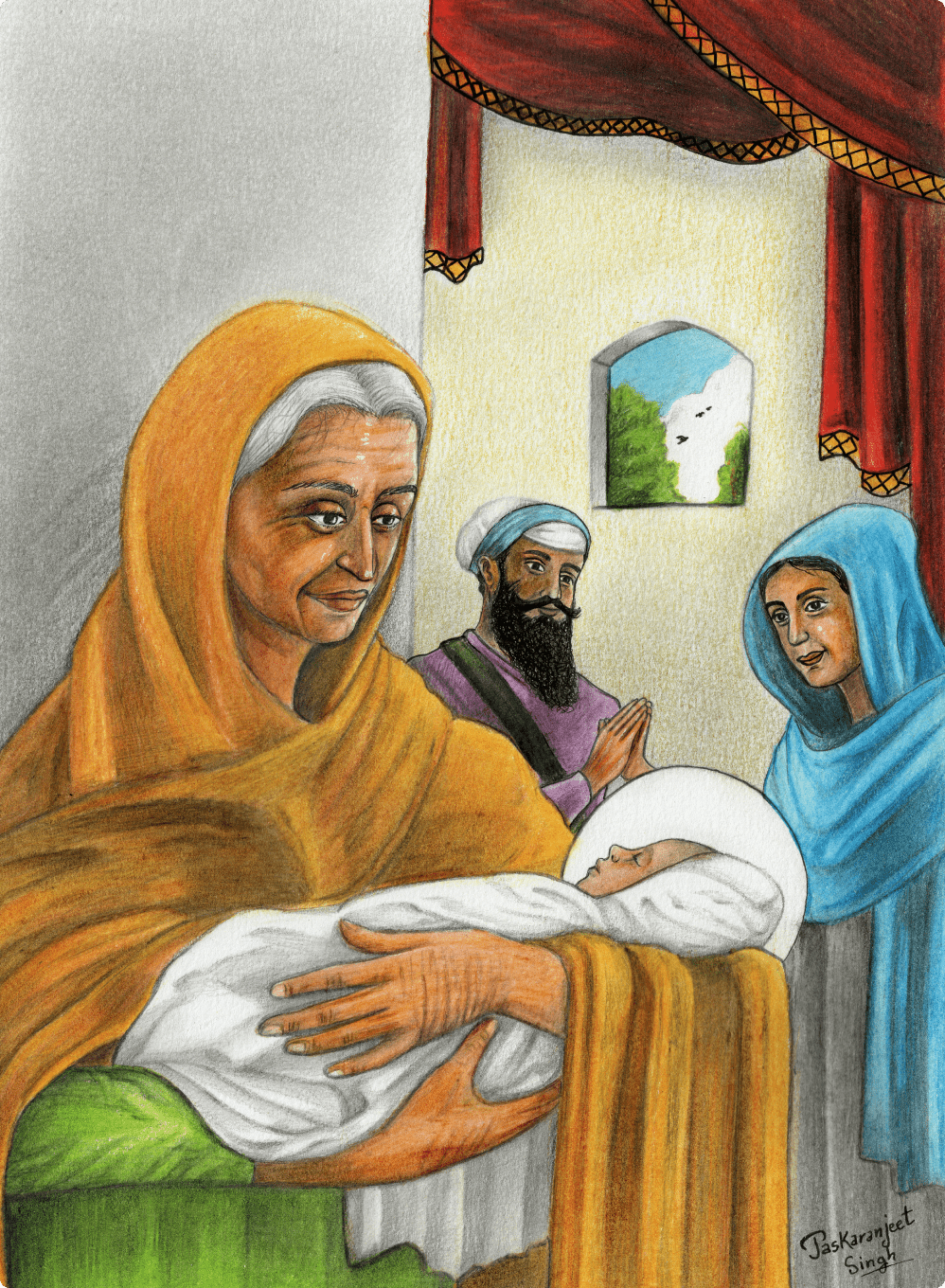
AUGUST
Artist: Jaskaran Singh, IND
Title: Mata Nanaki
Medium: Colour Pencils
Commissioner: Manmohn Johal
Title: Mata Nanaki
Medium: Colour Pencils
Commissioner: Manmohn Johal
Mata Nanaki, the wife of Guru Hargobind Sahib Ji, was a constant force of support of the Sikh
community in a way only akin to Baba Budha. Both lived exceptionally long lives and, while Baba
Budha lived to see six Gurus, Mata Nanaki would see and serve five Gurus, from Guru Arjan Dev Ji to
Guru Gobind Singh Ji.
Mata Nanaki saw the expansion of the Sikh community in Amritsar during Guru Hargobind Sahib Ji’s time.
She was a community leader during this period, travelling eastwards with her son [Guru Tegh Bahadur Ji] and Mata Gujri Ji. Mata Nanaki would help raise the young Gobind Rai while Guru Tegh Bahadur was travelling in Assam. Mata Nanaki was the constant force of support and guidance for the latter half of the Sikh period of physical Guruship.
In this image Mata Nanaki is cradling the young Gobind Rai with Kirpal Chand and Mata Gujri in the background.
Mata Nanaki saw the expansion of the Sikh community in Amritsar during Guru Hargobind Sahib Ji’s time.
She was a community leader during this period, travelling eastwards with her son [Guru Tegh Bahadur Ji] and Mata Gujri Ji. Mata Nanaki would help raise the young Gobind Rai while Guru Tegh Bahadur was travelling in Assam. Mata Nanaki was the constant force of support and guidance for the latter half of the Sikh period of physical Guruship.
In this image Mata Nanaki is cradling the young Gobind Rai with Kirpal Chand and Mata Gujri in the background.
Artist
Jaskaran Singh, IND
Jaskaran Singh is a self taught artist , who lives in Manchester (United Kingdom).
Born in Amritsar (India). He has a great interest in sikh history and loves to read
history based books. His work is mostly in mediums like pencil shading and charcoal,
as well as coloured pencils.
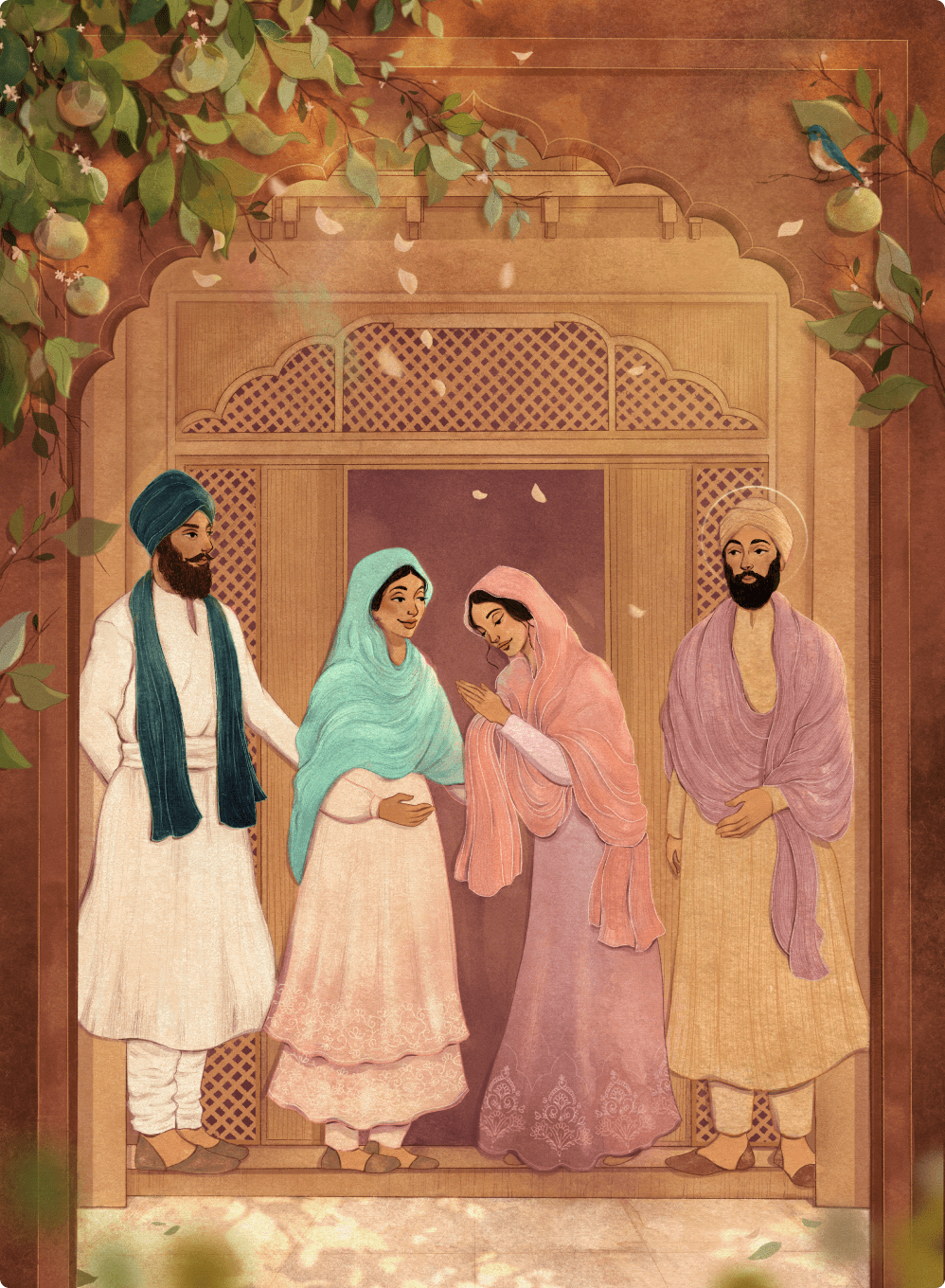
SEPTEMBER
Artist: Darsh Chetty, RSA
Title: Mata Solakhni
Medium: Mixed Media
Commissioner: Parmajit & Manjit Johal
Title: Mata Solakhni
Medium: Mixed Media
Commissioner: Parmajit & Manjit Johal
Mata Solakhni, the One with Great Qualities and the wife of Guru Nanak Dev Ji, was a pillar of
support for the foundation of the early Sikh community.
While she and Guru Nanak Dev Ji were still in their late teenage years, they moved in with Guru Nanak Dev Ji’s sister Bebe Nanaki and her husband Jairam in Sultanpur. It was here where Mata Solakhni would give birth to her two sons, Sri Chand and Lakhmi Das, who she raised her children with the unyielding support of Bebe Nanaki (who she held in the highest regard).
Whilst Guru Nanak Dev Ji proceeded on their travels across the world, Mata Solakhni and several other Sikhs sustained the local congregations in Panjab.
While she and Guru Nanak Dev Ji were still in their late teenage years, they moved in with Guru Nanak Dev Ji’s sister Bebe Nanaki and her husband Jairam in Sultanpur. It was here where Mata Solakhni would give birth to her two sons, Sri Chand and Lakhmi Das, who she raised her children with the unyielding support of Bebe Nanaki (who she held in the highest regard).
Whilst Guru Nanak Dev Ji proceeded on their travels across the world, Mata Solakhni and several other Sikhs sustained the local congregations in Panjab.
Artist
Darsh Chetty, RSA
Darshini Chetty is a South African – South Asian designer and illustrator. Although graduating with a degree in Architecture, her interest lies in all realms of visual art. She enjoys being able to visually narrate through design and art, by exploring the surreal through a blend of fantasy, nature and culture.
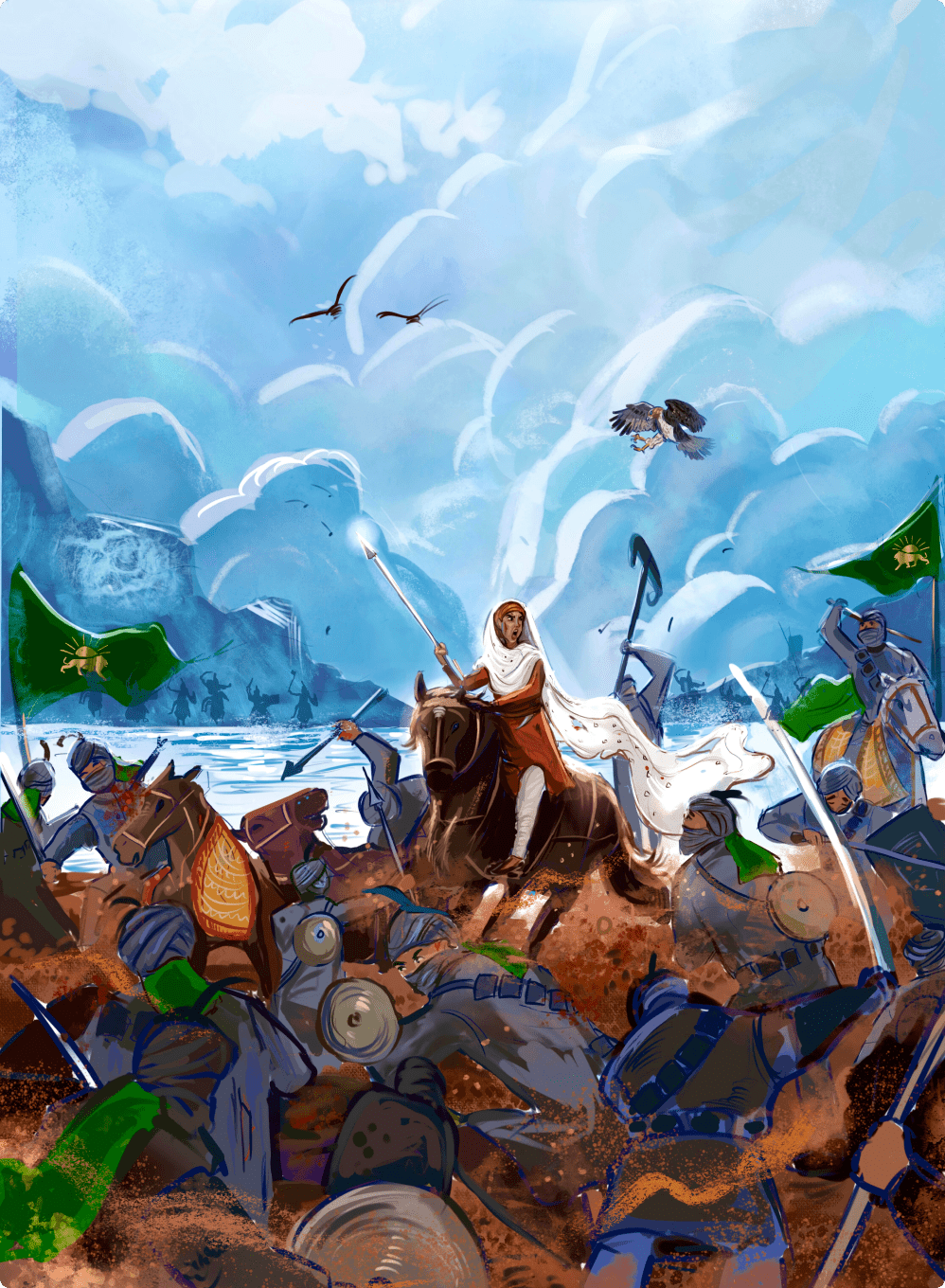
OCTOBER
Artist: Fathima Hakkim, UK
Title: Mai Bhago
Medium: Digital Art
Commissioner: Sanjiv Kumar
Title: Mai Bhago
Medium: Digital Art
Commissioner: Sanjiv Kumar
In 1704, Mughal Hill Chiefs surrounded the Guru in Anandpur Sahib; stating any man could leave on
the condition that they declared themselves as no longer being a Sikh of the Guru. 40 Sikhs agreed
to this and were made to sign a document by Guru Gobind Singh Ji declaring themselves as no longer
his Sikhs.
Mai Bhago was enraged when she heard of their desertion and confronted them upon their arrival at their home village. Her ferocious taunts led them to realise their shame, and they eagerly agreed to return to the battlefield, seeking forgiveness.
On their journey they intercepted a Mughal army pursuing the Guru. Mai Bhago and the 40 men fought the Mughals on horseback with spear in hand and forced them into retreat. All of the men had attained Shaheedi except for the seriously injured Mai Bhago. Guru Gobind Singh Ji forgave the 40 martyred men and proclaimed them as his Sikhs once again.
Mai Bhago was taken under the care of the Guru and went on to spend the rest of her life as a Nihangani, serving within the Guru’s army. She was one of the rare few, to be appointed as a personal guard for Guru Ji.
Mai Bhago was enraged when she heard of their desertion and confronted them upon their arrival at their home village. Her ferocious taunts led them to realise their shame, and they eagerly agreed to return to the battlefield, seeking forgiveness.
On their journey they intercepted a Mughal army pursuing the Guru. Mai Bhago and the 40 men fought the Mughals on horseback with spear in hand and forced them into retreat. All of the men had attained Shaheedi except for the seriously injured Mai Bhago. Guru Gobind Singh Ji forgave the 40 martyred men and proclaimed them as his Sikhs once again.
Mai Bhago was taken under the care of the Guru and went on to spend the rest of her life as a Nihangani, serving within the Guru’s army. She was one of the rare few, to be appointed as a personal guard for Guru Ji.
Artist
Fathima Hakkim, UK
Fathima Hakkim is an Indian illustrator based in London. She talks through paintings
that pens emotions through the style of magical surrealism and She uses light as a
talking point in her works and guides the viewers eye with dramatic colours.
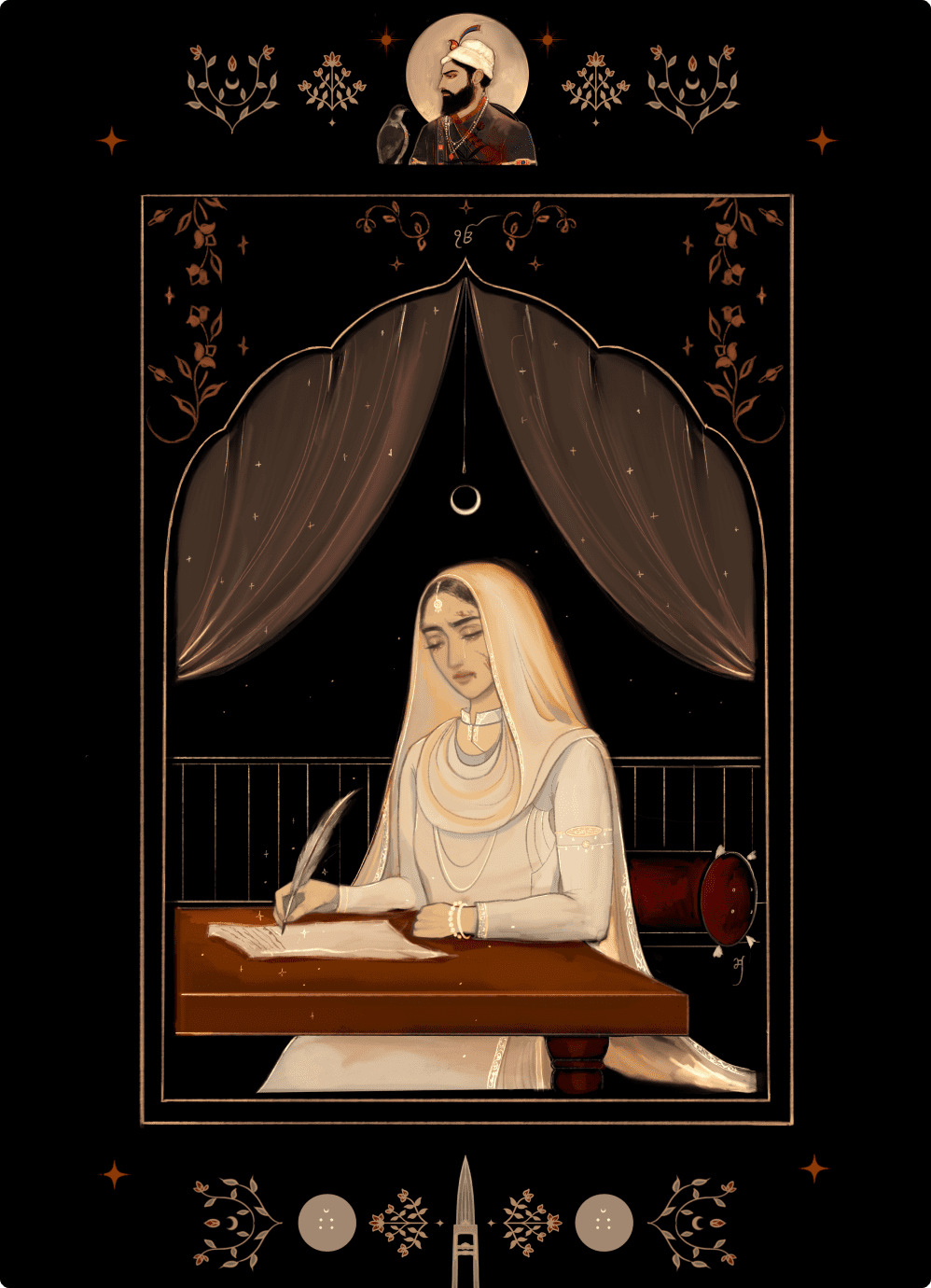
NOVEMBER
Artist: Harseerat Kaur, US
Title: Kaula
Medium: Digital Art
Commissioner: Narian Sidhu
Title: Kaula
Medium: Digital Art
Commissioner: Narian Sidhu
Kaula, the daughter of a Muslim priest named Rushtam Khan and a student of the Sufi saint Mian Mir,
lived a repressed lifestyle under her father’s watch. She found solace in Gurbani and the few
glimpses of Guru Hargobind Sahib Ji that she managed to catch, something that further drove a wedge
between her and her father’s relationship.
Rushtam Khan himself had previously cheated the Guru, by selling him a horse that was initially stolen from a Sikh. Eventually, the Guru, upon the consultation of Mian Mir, rescued Kaula from her Lahore home and allowed her to take up residence in Amritsar near Harmandir Sahib.
An incredibly enlightened and dedicated disciple of Guru Ji, she is memorialised by the Kaulsar Gurdwara Sahib, which adorns the Darbar Sahib complex.
Rushtam Khan himself had previously cheated the Guru, by selling him a horse that was initially stolen from a Sikh. Eventually, the Guru, upon the consultation of Mian Mir, rescued Kaula from her Lahore home and allowed her to take up residence in Amritsar near Harmandir Sahib.
An incredibly enlightened and dedicated disciple of Guru Ji, she is memorialised by the Kaulsar Gurdwara Sahib, which adorns the Darbar Sahib complex.
Artist
Harseerat Kaur, US
Harseerat Kaur is an artist and full time university student in California. She enjoys painting and experimenting with both digital and traditional mediums. For her, the encouragement to further explore and continue her pratice comes from the infinite treasure of inspiration that is Sikhi.

DECEMBER
Artist: Simran Kaur, UK
Title: Bibi Bhani
Medium: Miniature Paiing
Commissioner: Inderjit Deu
Title: Bibi Bhani
Medium: Miniature Paiing
Commissioner: Inderjit Deu
The daughter of Guru Amar Das Ji and the wife of Guru Ram Das Ji; Bibi Bhani is recounted in sources
as having an especially enlightened soul.
Guru Ram Das Ji only lived for six years after attaining the title of Guru and passed away at the age of 47. Bibi Bhani attained great spiritual enlightenment from the desire to serve her father Guru Amar Das Ji, and her spiritual insight guided her youngest son Guru Arjan Dev Ji to obtain the title of Guru.
The shabad Poota Mata Ki Aasees (loosely translated as, “o son, this is your mother’s blessing”) was a poem written in the voice of his mother by Guru Arjan Dev Ji. The shabad extols upon the guidance Guru Ji received from his mother upon his Gurgaddi at the age of 18.
Guru Ram Das Ji only lived for six years after attaining the title of Guru and passed away at the age of 47. Bibi Bhani attained great spiritual enlightenment from the desire to serve her father Guru Amar Das Ji, and her spiritual insight guided her youngest son Guru Arjan Dev Ji to obtain the title of Guru.
The shabad Poota Mata Ki Aasees (loosely translated as, “o son, this is your mother’s blessing”) was a poem written in the voice of his mother by Guru Arjan Dev Ji. The shabad extols upon the guidance Guru Ji received from his mother upon his Gurgaddi at the age of 18.
Artist
Simran Kaur, UK
I am a london-based artist, specialising in indian miniature painting and the use of natural, sustainable sources to create these works. My journey in traditional art aims to pick up and conserve the fine threads of ancient mastery, particularly those focusing around the Indian subcontinent – showcasing and educating the coming generations on the art of the lost worlds, where with God’s Grace, these techniques and form of spiritual practice are embraced and carried into the future. As a current student of the traditional arts and learning under the watchful eyes of many renowned masters in their practices, the path within my spiritual and physical practice has just begun.
My work also focuses on the use of natural resources such as earths and plants, where the journeys of these materials intertwine into the paintings and a collective energy is formed. I have only scratched the surface as a traditional artist, but may this ‘kalakaari’ lead to the divine truth, and bring the eyes of the future closer to the source from which they permeate from.














